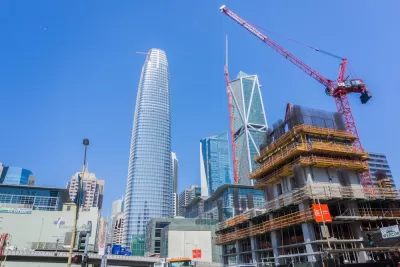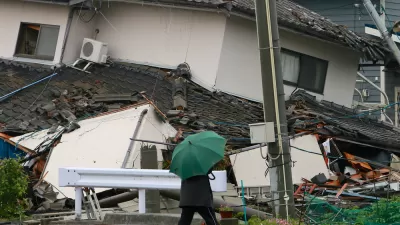The city has proposed tighter rules for new construction and a more active approach to securing existing tall structures from collapse.

Seismic activity has spooked San Francisco officials, who are now calling for stricter retrofitting measures, Rong-Gong Lin II writes. "First, a centerpiece of San Francisco's new downtown, the 58-story Millennium Tower, started sinking and tilting. Then last week, the city's new $2.26 billion transbay bus station was abruptly shut after cracks were found in two steel beams."
The city has released a list of over 150 tall buildings, including many constructed prior to modern seismic codes, as a prelude to assessing their need for retrofits. "The inventory comes with a sweeping proposal to more closely examine the city's skyline with an eye of making costly fixes to towers that could collapse amid major shaking. Officials are also calling for rules for new construction, aimed at preventing sinking of buildings as well as making tall buildings even stronger to resist wobbling in an earthquake."
These calls, Lin says, represent heightened rhetoric from several months ago, "when officials emphasized the difficulty in identifying the city's largest vulnerable buildings, such as those made of brittle concrete." Extant city laws, Lin continues, have not been particularly effective in requiring or spurring retrofits. "Current city law does require a seismic retrofit when two-thirds of a building's floors are renovated. But that almost never happens to tall buildings, when only a small fraction of the building undergoes construction at any given time."
FULL STORY: San Francisco Takes Unprecedented Step to Protect High Rises During Earthquakes

Planetizen Federal Action Tracker
A weekly monitor of how Trump’s orders and actions are impacting planners and planning in America.

Map: Where Senate Republicans Want to Sell Your Public Lands
For public land advocates, the Senate Republicans’ proposal to sell millions of acres of public land in the West is “the biggest fight of their careers.”

Restaurant Patios Were a Pandemic Win — Why Were They so Hard to Keep?
Social distancing requirements and changes in travel patterns prompted cities to pilot new uses for street and sidewalk space. Then it got complicated.

California Homeless Arrests, Citations Spike After Ruling
An investigation reveals that anti-homeless actions increased up to 500% after Grants Pass v. Johnson — even in cities claiming no policy change.

Albuquerque Route 66 Motels Become Affordable Housing
A $4 million city fund is incentivizing developers to breathe new life into derelict midcentury motels.

DC Area County Eliminates Bus Fares
Montgomery County joins a growing trend of making transit free.
Urban Design for Planners 1: Software Tools
This six-course series explores essential urban design concepts using open source software and equips planners with the tools they need to participate fully in the urban design process.
Planning for Universal Design
Learn the tools for implementing Universal Design in planning regulations.
Heyer Gruel & Associates PA
JM Goldson LLC
Custer County Colorado
City of Camden Redevelopment Agency
City of Astoria
Transportation Research & Education Center (TREC) at Portland State University
Camden Redevelopment Agency
City of Claremont
Municipality of Princeton (NJ)




























